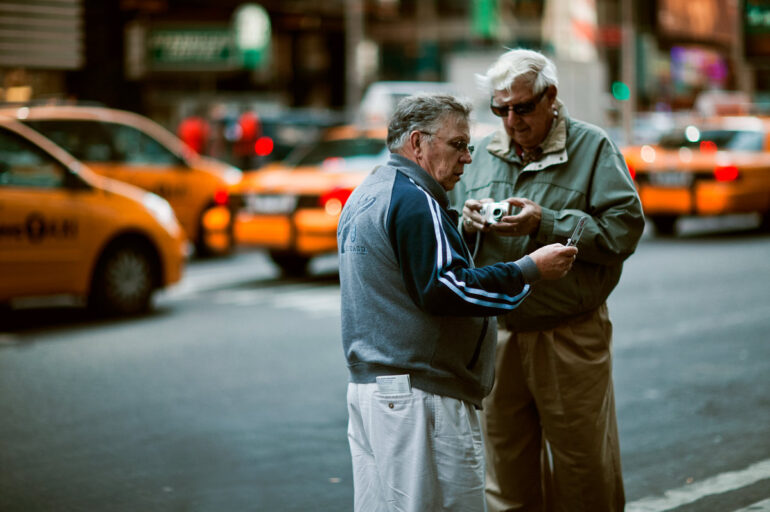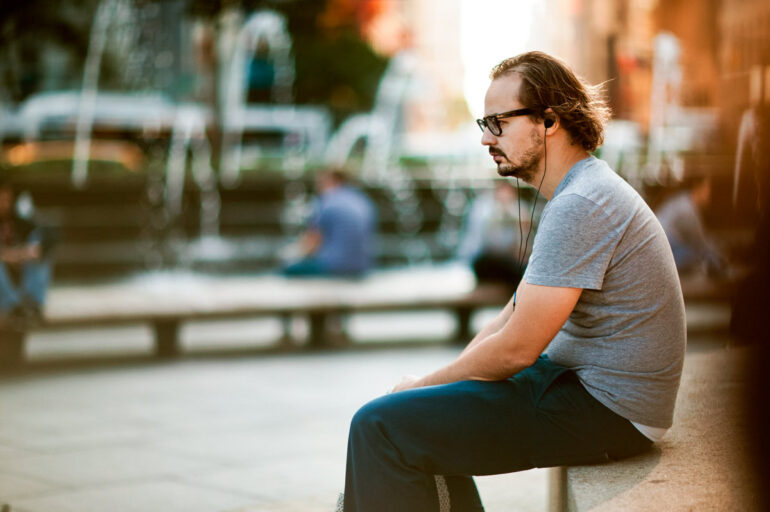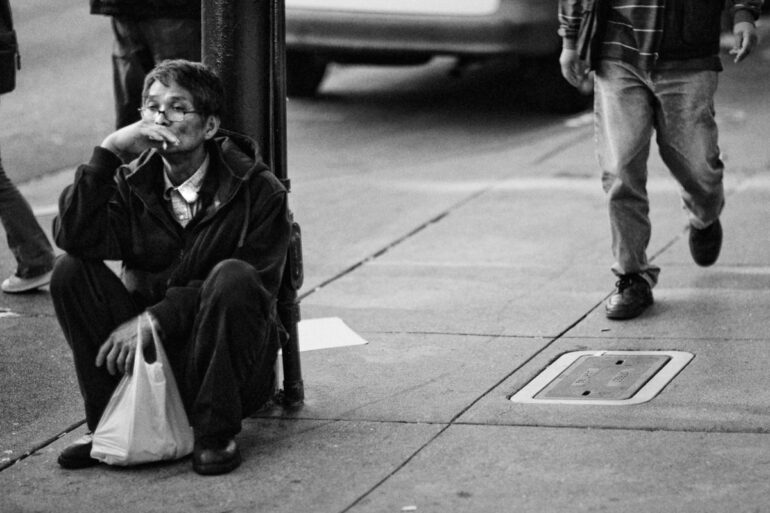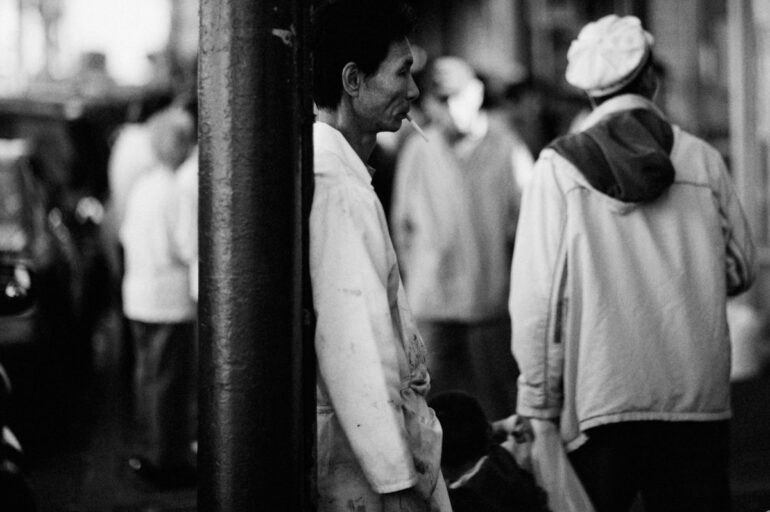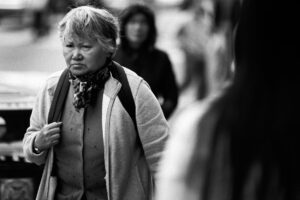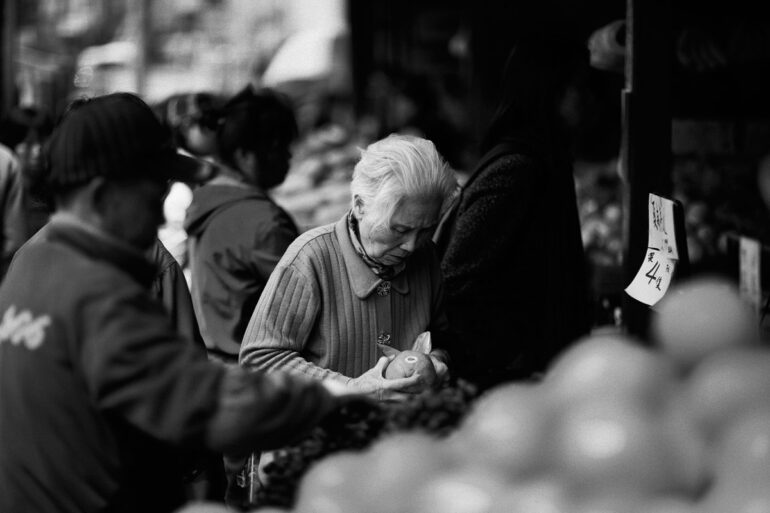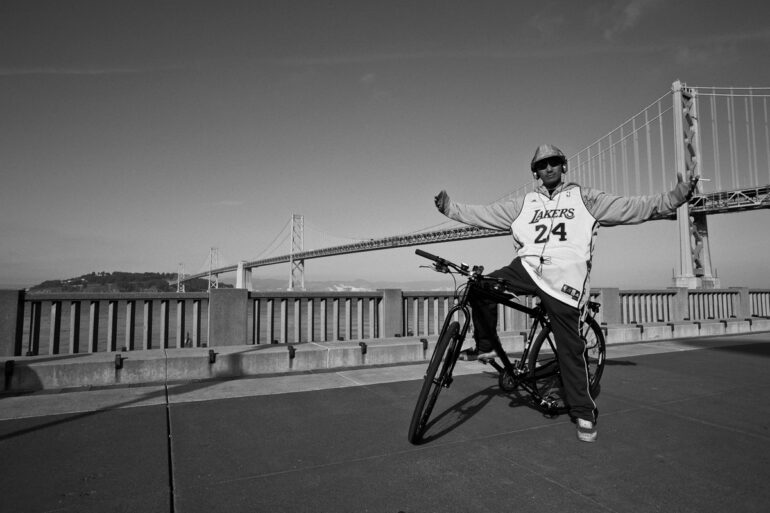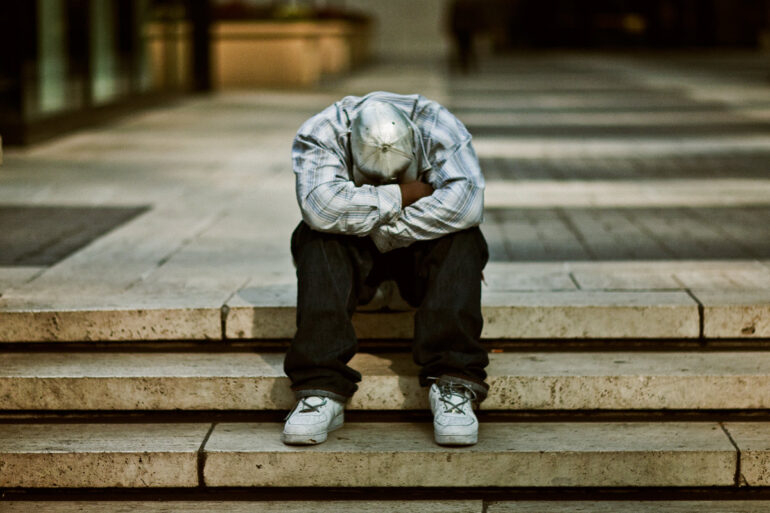We may earn a commission when you purchase through affiliate links. Learn more.
I love street photography. It’s a timeless genre of photography, capturing the drama of life and enabling the viewer to peer through a window into the lives, cultures, and behaviors of others. Even though photos capture only a fleeting instant, a good street photographer knows how to make that moment count. While documentary photography, photojournalism, and street photography all share similarities and often overlap each other, street photography sets itself apart by focusing less on specific events that are newsworthy and more on spontaneous moments that are usually captured candidly, without the subject’s knowledge.
While taking photos of people on the street often spurs intense debate about ethics online, the intent of street photography is to find beauty and intrigue in common, everyday situations that most people overlook. For generations, street photographers have captured images that have helped to define their times, photographing society at its best and worst moments and creating a powerful visual history of our world.
Just as fashion photography is usually more complex than simply taking a photo of someone wearing clothing, good street photography is often more complex than simply photographing someone out in public. While there isn’t one perfect or definitive style of street photography, there are some general concepts and suggestions that can help improve your own efforts.
Get Inspired
Street photography has a long and storied history. For well over 100 years, photographers have been developing their own unique styles and voices in street photography. I’ve always been a big believer that learning about the history of an art form can help to improve your own work. Looking through the work of other talented street photographers will not only inspire you to hit the streets with your camera, but it will allow you to closely examine the elements of their photos that make them successful — light, contrast, composition, depth, movement, etc…
There’s no substitute for getting out there and practicing, but observing the work of talented street photographers will help you to develop an eye for composition. A simple Google image search for street photography will bring up many examples; for photographers who like to have a more tangible library of inspiration, you’ll enjoy some of the many inspirational street photography books listed here.
Be Invisible
While some notable street photographers like to get up close and personal with their subjects, talking to them and getting to know their story while photographing them, the majority of street photography is done candidly.
Street photographers who shoot candid photos do so because they often feel that honest human emotions and interactions are captured best when their subjects aren’t aware that they’re being photographed. Think about how your own facial expression and body language shifts when you know someone is about to take your photo. Most of the best-loved street photography photos were taken close to their subject and tell a story. Getting close to your subjects without losing the magic of their honest, unguarded emotions isn’t easy. Invisibility is a difficult trick to master, and the more you get out and shoot, the better you will be at blending in.
A few tips to help you avoid sticking out:
Shoot with a smaller camera and lens
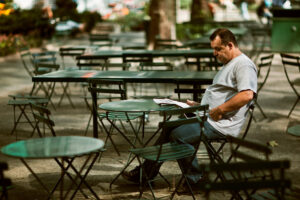 Just like a shiny red sports car is going to stand out more on the highway than a more common compact car, a huge professional DSLR camera paired with a massive lens is going to attract attention — lots of it. When you point a big camera in someone’s direction, the chances of them noticing increase dramatically. That’s not to say that you can’t shoot good street photography with a big interchangeable lens camera — you definitely can, but it’s going to be a bit more work, especially if you don’t have a lot of experience.
Just like a shiny red sports car is going to stand out more on the highway than a more common compact car, a huge professional DSLR camera paired with a massive lens is going to attract attention — lots of it. When you point a big camera in someone’s direction, the chances of them noticing increase dramatically. That’s not to say that you can’t shoot good street photography with a big interchangeable lens camera — you definitely can, but it’s going to be a bit more work, especially if you don’t have a lot of experience.
Advanced compact cameras like the Sony RX100 VII, Fujifilm X100V, and Ricoh GR IIIx are small enough so that they don’t draw much attention on the street, while still offering relatively large sensors, RAW capture and manual control over exposure settings like shutter speed, aperture, and ISO. I really like the Ricoh GRIIIx‘s ability to use Snap Focus mode, which allows you to preset a specific focusing distance, like 1 meter, 2 meters, 2.5 meters, etc… which is perfectly suited for street photography.
A bit larger than these advanced compact cameras are mirrorless cameras like the Canon R8, Sony a6700, and Fujifilm X-S20, which offer many of the benefits of DSLR cameras, such as interchangeable lenses, but in a more compact and lightweight body. The Canon R8 stands out for its full-frame sensor, excellent autofocus, and impressive image and video quality, making it an ideal choice for street photographers seeking high performance in a lightweight package, especially when paired with a lens like the RF50mm f/1.8 STM. The Sony a6700 is another strong contender, also boasting fast autofocus and a vast range of compatible lenses, including many affordable options from third-party manufacturers like Sigma and Tamron. Meanwhile, the Fujifilm X-S20 offers a unique experience with its excellent color science and versatile lens options, making it a favorite among photographers who appreciate Fujifilm’s distinctive aesthetic. For photographers who prefer the flexibility of interchangeable lenses and the familiar feel and functionality of a DSLR, mirrorless cameras are tough to beat.
DSLR cameras are generally bigger than mirrorless cameras, but they can certainly be used for street photography — as the adage goes, the best camera is the one you have with you. A few decades ago, a big SLR camera stood out much more than it does today. To keep weight down and to have as small a setup as possible, consider pairing your DSLR with a small prime lens like a 20mm, 35mm, or 50mm lens. A DSLR like the 24.1 Megapixel Canon EOS Rebel SL3 paired with a Canon EF 50mm f/1.8 STM lens makes for an excellent street photography setup.
Look Beyond Your Subjects or Compose the Shot before they Enter the Frame
A technique I frequently use when shooting street photography is to look beyond the people I’m photographing. Without making eye contact with your subject, this technique can make it seem as if you’re photographing something behind them and won’t draw their attention to you. With a wide angle lens, it’s easy to aim your camera beyond your subject while still keeping them in the frame.
Another technique is to compose your shot before a subject who is walking enters the frame. To pull this technique off you’ll want to set your focus ahead of time and wait for the person to reach the right spot. Using a tiny aperture (higher f-stop number) will help to keep your subject in focus. (Learn more about how aperture works here) Because you already had your camera to your eye before they walked in front of it, most people won’t be aware that you actually intended to photograph them.
Shoot from the Hip
While there are techniques you can use to be less obvious while taking photos, shooting from the hip or from anywhere that doesn’t involve putting the camera up to your eye is a popular technique for being less obvious while shooting candid street photography.
People naturally associate a camera raised to the eyes to mean that someone is taking a picture, so learning how to take good photos without needing to look through the viewfinder can improve your invisibility on the street. This is a really tough technique to master — your first shots will probably be out of focus and crooked, but with some practice you will get better and better. When shooting from the hip with a MILC or DSLR, you’ll want to use a wide angle prime lens like the Canon 20mm f/2.8 or Canon 24mm f/2.8 or the Nikon 20mm f/2.8 or Nikon 28mm f/2.8 which will allow you to capture the full body of your subject as well as plenty of background to give your shot some depth.
Using this technique, a wide angle lens is the way to go, capturing a greater field of view than a 50mm or 85mm lens would be able to. If you don’t have your subject perfectly framed or if the camera was tilted a bit the wrong way, a wide angle lens allows you a lot more freedom to crop your shots later to correct these issues.
To improve your percentage of keeper shots taken while shooting street photography from the hip, use a fast shutter speed — 1/250th to 1/500th should be enough to freeze most action. If you use a slower shutter speed than this, you’ll greatly increase your chances of blurry photos, caused by camera shake and subject movement.
When shooting from the hip, you definitely need to use manual focus — because it’s tough to control exactly where your camera is pointing when you can’t aim it from the eye, autofocus will almost always select the wrong focus point, or spend valuable seconds searching. Prefocus to a set distance in front of you that’s easy for you to estimate — 5 to 10 feet is usually about right if you’re using a wide angle lens and with a little practice you’ll be able to tell when your subject should be in focus.
Think about Composition and Timing
The difference between a bad photo, a good photo, and a great photo can often be a difference of only a few seconds. Street photography (and really any type of photography) is all about creating a connection between your scene or subject and the viewer. A great street photo is composed in a way that draws the eye to the important part of the scene and makes your viewer empathize with the emotions of your subject. A few seconds can be the difference between someone gesturing or sitting still again.
Be conscious of how you compose your images. Rather than just placing your subject in the middle of the frame, experiment with various compositions. Pay attention to your exposure settings and have your camera ready to take the shot before you even know what the shot will be. Fiddling with your camera settings while aiming a camera at someone is a great way to draw attention to yourself.
Observing and learning from the work of other street photographers is one of the best ways to improve your own composition. Look at your favorite shots by others and ask yourself what it is about those images that makes them have an impact.
Don’t try to Hide While Taking Street Photos
While taking candid photos requires plenty of skill and some ninja-level invisibility techniques, sneaking around and lurking behind trees is not the same thing as blending in. Confidence is a tough trick to master as a street photographer, but learning how to walk around in public while taking photos of people without feeling nervous is important.
With millions of people taking photos with camera phones, point and shoots, and even bigger mirrorless and DSLR cameras most people no longer even pay attention when they see someone with a camera. They do pay attention when they see a guy hiding behind a tree, however.
Approaching people you don’t know on the street and taking their photograph takes guts and courage, even if you aren’t letting them know you’re taking their picture. There is always a chance that someone will notice you — a confident photographer will just smile and take it in stride if that happens, but a nervous photographer will look down and quickly walk away — suspicious behavior that just draws attention from everyone nearby and makes people think that you were doing something nefarious. If you saw someone take a picture of you, how would you react? You probably wouldn’t care, as long as they didn’t seem like they were up to no good, and this is how most people would respond as well.
Some street photographers have a guilty conscience about what they’re doing, feeling more like peeping Toms doing something wrong rather than visual artists capturing powerful moments on the streets. If you approach street photography with this attitude, you’re going to end up looking creepy when you try too hard to hide what you’re doing. Keep shooting, and your confidence will grow.
Choose Interesting Subjects for your Street Photography
The truth is that we all shoot really boring photos from time to time — maybe even most of the time. Sometimes things just don’t look as good as we hoped they would — maybe someone walked through our shot or the lighting wasn’t quite right. There are always things we can’t control, but what we can control is what and who we choose to photograph. Look for subjects who look interesting and are engaged in an activity or situation that you can use to create a story with through your street photography. Many new street photographers walk around taking photos of everyone they see — you’ll get a few keepers using this method, but if you take your time and look specifically for interesting subjects you might end up with a few less shots at the end of the day, but you’re likely to have more keepers.
It’s ok to take several images of a single scene, experimenting with composition and angles and exposure — the masters of street photography like Henri Cartier-Bresson certainly did. When you’re shooting, try to be conscious of what you’re shooting — holding down the shutter and crossing your fingers might work sometimes, but you’ll get the best results if you try to compose each shot and are aware of what’s going on in your scene. Shoot as much as you can, but try to always think about each shot.
Above all, what helps to separate the decent photographers from the great photographers is an ability to be critical of your own work, to know when an image is a keeper and when it isn’t. If you are able to critique your own work, you’ll become a much stronger photographer.

